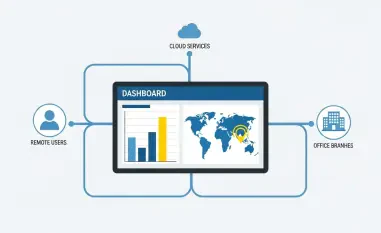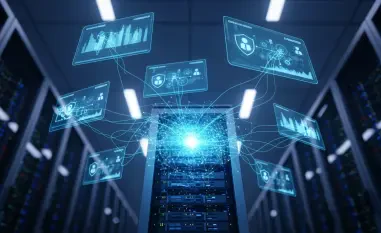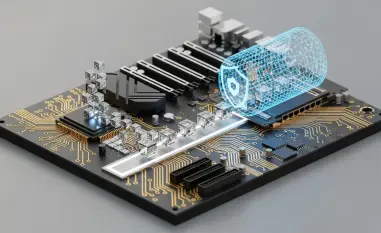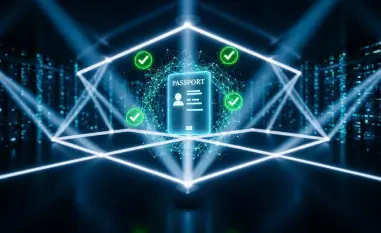In the rapidly evolving landscape of cybersecurity, organizations face unprecedented challenges. The complexity and sophistication of cyber threats have grown exponentially, necessitating advanced defense strategies. Reflecting on historical communication methods like smoke signals, it becomes clear that modern organizations must develop robust cyber defense mechanisms to achieve true cyber resilience by 2025.
The Evolving Cyber Threat Landscape
The Rise of Sophisticated Cyber Attacks
In 2024, technology leaders and security teams encountered significant challenges due to the increasing complexity of cyber threats. The advent of generative AI (GenAI) has empowered cybercriminals to launch more sophisticated attacks, enhancing traditional threats like phishing with increased authenticity. This has forced organizations into a reactive stance, creating an overwhelmingly complex security environment. The sophistication of these attacks often overwhelms traditional cybersecurity infrastructure, rendering many outdated defenses nearly ineffective.
As cybercriminals grow more proficient with GenAI, the threat landscape continues to evolve. These advanced technologies facilitate the creation of phishing emails that are indistinguishable from legitimate communication, lead to automated exploitation of vulnerabilities, and generate sophisticated ransomware that evades detection. Consequently, security teams are constantly playing catch-up, struggling to anticipate and counteract these rapidly evolving threats. This adversarial dynamic results in a perpetual state of heightened alert, consuming vital resources and increasing the necessity for more effective cyber defense strategies.
The Impact of Generative AI on Cybersecurity
Generative AI has had a twofold effect on cybersecurity. While it has enabled more sophisticated attacks, it has also necessitated a reactive approach from organizations. This has led to a complex security environment where traditional defense mechanisms are no longer sufficient. Organizations must now adopt advanced strategies to stay ahead of cybercriminals. Over time, the sophistication of AI-driven attacks has revealed significant vulnerabilities within existing cybersecurity frameworks, compelling organizations to shift their focus to proactive defense mechanisms.
The need for these advanced strategies has never been more apparent. GenAI’s ability to adapt and evolve means that static security protocols quickly become obsolete. To counteract this, organizations are investing in adaptive and dynamic security measures capable of responding to emerging threats in real time. These include leveraging AI for threat detection, employing behavioral analysis models to identify anomalies, and employing advanced encryption techniques to protect sensitive data. By integrating these sophisticated tools into their cybersecurity infrastructure, organizations aim to outpace cybercriminals and establish a more robust, resilient defense posture.
Technology Rationalization: A Key Strategy
Understanding Technology Rationalization
Technology rationalization involves a systematic review and assessment of an organization’s technology stack. This process aims to identify coverage gaps, redundancies, and ensure full utilization of existing tools. By streamlining systems, organizations can achieve holistic visibility into their cybersecurity posture and risks. This holistic approach facilitates a more strategic allocation of resources, allowing security teams to prioritize high-impact areas and optimize their defensive strategies. The goal is to minimize complexity while maximizing the effectiveness of cybersecurity measures.
Implementing technology rationalization requires a comprehensive audit of the entire technology stack. This audit process identifies underutilized or redundant tools, discovers gaps in coverage, and highlights opportunities for integration and enhancement. By eliminating unnecessary, overlapping technologies, organizations can reduce the surface area for potential attacks and simplify their management processes. This not only results in cost savings but also provides a more focused and efficient approach to cybersecurity. As organizations streamline their technology infrastructure, they can repurpose resources towards proactive threat mitigation and more sophisticated security initiatives.
Benefits of Technology Rationalization
The primary benefit of technology rationalization is the creation of a more efficient technology infrastructure. This allows security teams to shift their focus from managing internal operations to acting on external threats. As a result, organizations can better allocate resources and improve their overall cyber defense capabilities. Additionally, rationalized technology stacks enhance the organization’s ability to adapt to emerging threats, providing more agility in their cybersecurity posture.
Optimized technology utilization supports faster reaction times to incidents and more effective threat mitigation strategies. Security teams can leverage integrated systems to gain a comprehensive view of potential vulnerabilities and threats, facilitating quicker, more informed decision-making. Furthermore, a streamlined technology stack reduces the complexity involved in maintaining cybersecurity infrastructure, lowering the risk of human error and improving overall system reliability. In turn, this enhanced operational efficiency results in more robust, proactive, and resilient cybersecurity practices, enabling organizations to navigate the evolving threat landscape more confidently.
Building a Defense-in-Depth Strategy
The Importance of a Multi-Layered Approach
A defense-in-depth strategy involves building multiple security layers on top of technology rationalization. This approach is essential for counteracting sophisticated cyber threats effectively. By implementing various security measures, organizations can create a robust defense mechanism that is difficult for cybercriminals to penetrate. Defense-in-depth involves integrating a range of security controls across different areas, such as network security, endpoint protection, access controls, and data security, to create a comprehensive shield against potential attacks.
This multi-layered strategy ensures that even if one security measure fails, others remain in place to protect critical assets. Each layer serves a specific purpose and complements the others, creating a cohesive and resilient security framework. This approach also allows for scalability and flexibility, enabling organizations to continually adapt to the evolving threat landscape. By combining various technologies and practices, such as encryption, intrusion detection systems, and behavioral analytics, organizations can build a more impenetrable defense, reducing the likelihood of successful cyberattacks and minimizing the impact of any potential security breaches.
Key Components of a Defense-in-Depth Strategy
Several key components are expected to take precedence in 2025. These include zero trust frameworks, governance, risk, and compliance (GRC) programs, data protection platforms, and the integration of AI and machine learning (ML) technologies. Each of these components plays a crucial role in enhancing an organization’s cyber defense capabilities. Zero trust frameworks, for example, enforce strict user verification and limit access based on continuous assessment, significantly reducing the risk of unauthorized access and lateral movement within a network.
At the same time, GRC programs provide a structured approach to managing cybersecurity risks and regulatory requirements. This ensures that organizations adhere to industry standards and remain compliant with various laws and regulations, further strengthening their defense posture. Data protection platforms safeguard sensitive information and intellectual property, providing an additional layer of security against breaches. Meanwhile, AI and ML technologies enhance threat detection and response capabilities, enabling organizations to stay ahead of sophisticated cyberattacks. By integrating these key components into a cohesive defense-in-depth strategy, organizations can build a robust and adaptive security framework capable of countering even the most advanced cyber threats.
Zero Trust Frameworks
The Principle of “Never Trust, Always Verify”
Zero trust frameworks emphasize the principle of “never trust, always verify.” This approach limits lateral movements by bad actors and mitigates the impact of ransomware attacks. By adopting micro-segmentation and shifting from traditional perimeter-based security to identity verification and stringent access controls, organizations can enhance their security posture. In essence, zero trust necessitates continuous verification of all users and devices, regardless of their location or previous authentication status, to ensure they adhere to security policies.
This shift from a castle-and-moat approach to a more granular security model significantly reduces the attack surface. By verifying every access request and segmenting networks to minimize lateral movement, zero trust frameworks prevent unauthorized users from moving freely within a network. This reduces the impact of breaches and confines potential threats to limited segments of the network. Furthermore, the principle of least privilege is enforced, granting users the minimum access necessary to perform their tasks, thereby reducing the potential for insider threats and accidental misuse of sensitive information.
Implementing Zero Trust in Organizations
To implement zero trust frameworks effectively, organizations must adopt a comprehensive approach. This includes continuous monitoring, strict access controls, and regular security assessments. By doing so, organizations can ensure that only authorized users have access to critical systems and data. Continuous monitoring involves tracking user activities and behaviors in real time to detect any suspicious or anomalous actions. This proactive surveillance helps in identifying potential threats and mitigating them before they can cause significant harm.
Moreover, implementing zero trust requires a cultural shift within the organization. Staff must be educated on security best practices and the importance of adhering to zero trust principles. Regular security assessments and audits are crucial in identifying and addressing vulnerabilities within the network. Additionally, integrating advanced technologies such as multi-factor authentication (MFA), encryption, and identity and access management (IAM) solutions can further bolster zero trust implementations. By establishing a zero trust framework, organizations can significantly enhance their resilience against sophisticated cyber threats and foster a more secure operational environment.
Governance, Risk, and Compliance (GRC)
The Growing Importance of GRC Programs
In 2025, there will be an increased focus on maturing GRC programs. This is driven by the necessity to manage third-party and supply chain risks, as well as comply with heightened regulatory and oversight requirements. Updates to the Cybersecurity Maturity Model Certification (CMMC) will impose considerable cybersecurity stipulations on defense contractors and their suppliers’ management of government data. As industries become more interconnected, the importance of robust GRC programs becomes paramount in ensuring holistic risk management and regulatory compliance.
Effective GRC programs encompass various dimensions of cybersecurity, including risk assessment, policy management, compliance monitoring, and incident response planning. By systematically addressing these areas, organizations can identify potential risks, implement appropriate controls, and monitor compliance with regulations and standards. This proactive approach not only minimizes the likelihood of security breaches but also ensures that organizations can swiftly respond to incidents, maintaining the integrity and availability of critical information systems. Consequently, GRC programs are integral to sustaining a resilient cybersecurity posture in an increasingly complex and regulated digital landscape.
Enhancing GRC Programs
To enhance GRC programs, organizations must adopt a proactive approach. This includes regular risk assessments, continuous monitoring, and compliance with regulatory requirements. By doing so, organizations can effectively manage risks and ensure the security of their systems and data. Risk assessments involve identifying potential threats, evaluating their impact, and implementing measures to mitigate them. Continuous monitoring ensures that these measures remain effective and that any emerging risks are promptly addressed.
Moreover, the integration of advanced GRC tools and technologies can streamline compliance efforts and improve risk management practices. These tools facilitate automated policy enforcement, real-time risk assessment, and comprehensive audit capabilities, enabling organizations to maintain compliance with minimal manual intervention. Additionally, fostering a culture of compliance within the organization is crucial. This involves educating employees about the importance of adhering to regulatory requirements and best practices. By cultivating a proactive and compliant organizational culture, businesses can enhance their GRC programs and build a strong foundation for cybersecurity resilience.
Data Protection Platforms
Addressing Security Concerns with GenAI
As GenAI enhances productivity, it also introduces significant security concerns. The vast amounts of data, including sensitive information, used to train AI models must be protected. Effective data protection programs are essential to safeguard personal information and intellectual property. Implementing robust data protection measures ensures that data remains secure throughout its lifecycle, from collection and storage to processing and transmission.
One of the primary concerns with GenAI is the potential for data breaches and leaks. AI models require vast datasets, often containing sensitive information, to function effectively. If these datasets are not adequately protected, they become prime targets for cybercriminals. Breaches not only compromise personal information but can also expose proprietary business data, leading to significant financial and reputational damage. Therefore, organizations must prioritize data protection by implementing encryption, access controls, and regular security assessments to mitigate these risks and ensure the integrity of their AI-driven processes.
Implementing Data Protection Measures
Organizations must implement robust data protection measures to ensure compliance with privacy regulations and uphold ethical standards. This includes encryption, access controls, and regular security assessments. By doing so, organizations can prevent AI biases and misinformation, ensuring the integrity of their data. Encryption ensures that data remains confidential and secure, even if it is intercepted by unauthorized parties. Access controls limit the availability of data to authorized personnel only, reducing the risk of internal threats and data misuse.
Regular security assessments identify potential vulnerabilities and areas for improvement within the data protection framework. These assessments should be conducted periodically to ensure that the measures in place remain effective against evolving threats. Additionally, organizations must stay abreast of changing privacy regulations and industry standards to maintain compliance. By integrating best practices and advanced technologies into their data protection strategies, businesses can safeguard their critical information assets, foster trust with stakeholders, and enhance their overall cybersecurity posture in the face of advancing AI-driven capabilities.
AI and Machine Learning (ML) Integration
Leveraging AI and ML for Cyber Defense
While adversaries leverage GenAI to enhance their capabilities, organizations can also utilize AI and ML to bolster cyber defense. These technologies improve monitoring capabilities, threat detection and response, and advanced threat hunting and incident response systems. AI and ML algorithms can analyze vast amounts of data in real-time, identifying patterns and anomalies that may indicate potential threats. This enables security teams to respond more quickly and effectively to emerging risks.
Moreover, AI-driven tools can automate many aspects of cybersecurity, reducing the burden on human analysts and allowing them to focus on more complex tasks. Automated threat detection and response systems can swiftly identify and mitigate risks, preventing breaches before they cause significant damage. Additionally, advanced threat hunting techniques, powered by AI and ML, enable organizations to proactively seek out and address vulnerabilities within their networks. By integrating AI and ML technologies into their cybersecurity infrastructure, organizations can enhance their threat detection and response capabilities, ultimately creating a more resilient defense against sophisticated cyber threats.
Enhancing Cyber Defense with AI and ML
In today’s fast-paced world of cybersecurity, organizations face greater challenges than ever before. The complexity and sophistication of cyber threats have grown immensely, making advanced defense strategies a necessity. Unlike historical communication methods, such as smoke signals, modern organizations require far more robust mechanisms to guard against cyber risks. Cyberattacks are becoming increasingly intricate, often involving multiple stages and advanced techniques designed to bypass traditional security measures.
As we approach 2025, achieving cyber resilience is vital. This means not just deterring and detecting threats, but also swiftly responding to and recovering from attacks. Organizations must invest in cutting-edge technologies and adopt comprehensive cybersecurity frameworks to stay ahead. Employee training, real-time threat intelligence, and regular security assessments are essential components of a resilient cyber defense strategy. Collaborations within the cybersecurity community also play a critical role, allowing for the sharing of best practices and emerging threat information. Therefore, developing robust cyber defense mechanisms is crucial for modern organizations to thrive in an increasingly digital world.













